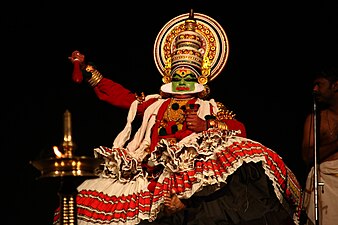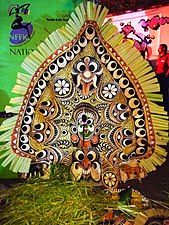
Koodiyattam is a traditional performing art form in the state of Kerala, India. It is a combination of ancient Sanskrit theatre with elements of Koothu, an ancient performing art from the Sangam era. It is officially recognised by UNESCO as a Masterpiece of the Oral and Intangible Heritage of Humanity.

Ottan Thullal is a recite-and-dance art-form of Kerala, India. It was introduced in the eighteenth century by Kunchan Nambiar, one of the Prachina Kavithrayam. The folksy performance, often laced with humour intended at criticism of society, is accompanied by a mridangam and/or the handy idakka besides a pair of ilathalam cymbals.
The Malayali people are a Dravidian ethnolinguistic group originating from the present-day state of Kerala in India, occupying its southwestern Malabar coast. They are predominantly native speakers of the Malayalam language, one of the six classical languages of India. The state of Kerala was created in 1956 through the States Reorganisation Act. Prior to that, since the 1800s existed the Kingdom of Cochin, the Kingdom of Travancore, Malabar District, and South Canara of the British India. The Malabar District was annexed by the British through the Third Mysore War (1790–92) from Tipu Sultan. Before that, the Malabar District was under various kingdoms including the Zamorins of Calicut, Kingdom of Tanur, Arakkal kingdom, Kolathunadu, Valluvanad, and Palakkad Rajas.

Kunchan Nambiar was a prominent Malayalam poet of the 18th century (1705-1770). Apart from being a prolific poet, Nambiar is also famous as the originator of the dance art form of Thullal, most of his works were written for use in Thullal performances. Social criticism wrapped in humour is the hallmark of his works. Nambiar is one of the foremost comedians in Malayalam.
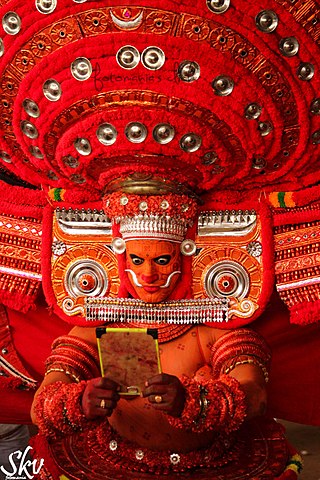
Theyyam is a Hindu religious ritual practiced in northern Kerala and some parts of Karnataka. Theyyam is also known as Kaḷiyāṭṭaṁ or Tiṟa. Theyyam consists of traditions, rituals and customs associated with temples and sacred groves of Malabar. The people of the region consider Theyyam itself as a channel to a god and they thus seek blessings from Theyyam.

Kerala Kalamandalam, a deemed-to-be-University of Art and Culture by the Government of India, is a major centre for learning Indian performing arts, especially those that developed in the country's southern states, with special emphasis on those from Kerala. The institution, on the banks of the Bharathapuzha river, is situated in the small town of Cheruthuruthi in Thrissur district.

Mani Damodara Chakyar is a Kutiyattam and Chakyar Koothu artist in Kerala state of south India. He is a nephew and disciple of legendary guru Nātyāchārya Vidūshakaratnam Padma Shri Māni Mādhava Chākyār. He belongs to the great Mani Chakyar tradition of Koodiyattam and Chakyar koothu.
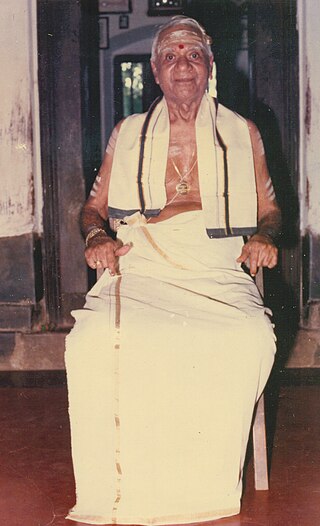
Guru Mani Madhava Chakyar (15 February 1899 – 14 January 1990) was a celebrated master performance artist and Sanskrit scholar from Kerala, India, considered to be the greatest Chakyar Koothu and Koodiyattam artist and authority of modern times. He was considered as the authority of Abhinaya and Nātyaśāstra.

Chakyar Koothu is a performance art from Kerala, India. It is primarily a type of highly refined monologue where the performer narrates episodes from Hindu epics and stories from the Puranas. Sometimes, however, it is also a traditional equivalent of the modern stand-up comedy act, incorporating commentary on current socio-political events.

The culture of Kerala has developed over the past millennia, influences from other parts of India and abroad. It is defined by its antiquity and the organic continuity sustained by the Malayali people. Modern Kerala society took shape owing to migrations from different parts of India and abroad throughout Classical Antiquity.

Kerala, a state situated on the tropical Malabar Coast of southwestern India, is one of the most popular tourist destinations in the country. Named as one of the ten paradises of the world by National Geographic Traveler, Kerala is famous especially for its ecotourism initiatives and beautiful backwaters. Its unique culture and traditions, coupled with its varied demography, have made Kerala one of the most popular tourist destinations in the world. Several international agencies ranging from UNESCO to National Geographic have recognised the state's tourism potential. Kerala was named by TIME magazine in 2022 among the 50 extraordinary destinations to explore in its list of the World's Greatest Places. In 2023, Kerala was listed at the 13th spot in The New York Times' annual list of places to visit and was the only tourist destination listed from India.

Killikkurussimangalam is a village around 8 km from nearby town Ottappalam in Palakkad district of Kerala, south India. The river Nila (Bharatapuzha) flows through the southern border of Lakkidi.
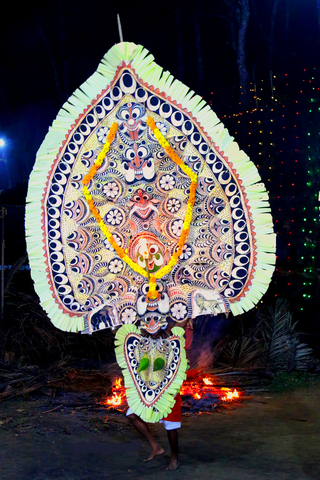
Padayani, also known Padeni, is a traditional folk dance and a ritual art from the central portion of the Indian state of Kerala. A ceremonial dance involving masks, it is an ancient ritual performed in Bhagavati temples. The dance is performed in honor of Bhadrakaali. Meaning, a 'row of warriors', Padayani is an art form that blends all music, dance, theatre, satire, facial masks, and paintings. It is part of worship of Bhadrakali and is staged in temples dedicated to the goddess from mid-December to mid-May. Padayani is unique to central Travancore, comprising the Pathanamthitta and Kottayam districts of Kerala. It is also performed in adjoining regions of Kollam, Alappuzha districts.

The following outline is provided as an overview of and topical guide to Kerala:
Kalamandalam V. Satyabhama was an Indian classical dancer, teacher and choreographer, known for her performances and scholarship in mohiniyattam. She was awarded the Padma Shri, in 2014, for her contributions to the art and culture, by the Government of India.
Kalamandalam Sivan Namboodiri is an Indian classical theatre performer, the first person from outside chakyar community to practice Koodiyattam, from Kerala. He was awarded the Padma Shri, in 2012, for his contributions to the art of Koodiyattam, by the Government of India.

Parayan Thullal is a dance and poetic performance form prevailed in the state of Kerala, India. This one of the three major thullal forms prevailing in Kerala. Others are Ottan Thullal and Sheethankan Thullal. Usually, it is conducted in the morning time. The Sanskrit metre Mallika is commonly used in this art form.

South Malabar refers to a geographical area of the southwestern coast of India covering some parts of the present-day Kerala. South Malabar covers the regions included in present-day Kozhikode taluk of Kozhikode district, the whole area of Malappuram district, Chavakkad taluk of Thrissur district, and Palakkad district, excluding parts of Chittur taluk. The Fort Kochi region of Kochi city also historically belongs to South Malabar. The term South Malabar refers to the region of the erstwhile Malabar District south to the river Korapuzha, and bears a high cultural similarity to both the Cochin and the North Malabar region.

Nambiarath Appunni Tharakan is a Kathakali artist from Kerala, India. He work as Uduthukettal expert at aniyara of Kathakali. He received several awards including Kerala Sangeetha Nataka Akademi Award, Kerala Kalamandalam Award for Best Kathakali Aniyara Artist and Kerala Kalamandalam Mukundaraja Award.
Kerala Sangeetha Nataka Akademi Award is an award given by the Kerala Sangeetha Nataka Akademi, an autonomous organisation for the encouragement, preservation, and documentation of the performing arts of Kerala, set up by the Department of Cultural Affairs of the Government of Kerala. Instituted in 1962, the awards are given in the categories of music, dance, theatre, other traditional arts, and for contribution/scholarship in performing arts. The award consists of Rs. 30,000, a citation and a plaque. The recipients of the award are also conferred the title Kalasree.


